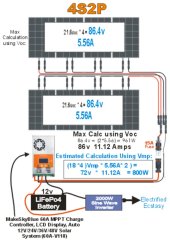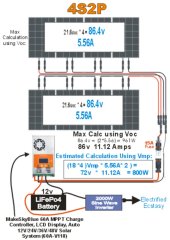Selectively cheery picking things to bolster your argument. The MSB at 60a can easily expand by going to a 24v or 48v battery setup. Plus even following your argument $283 dollars can buy a lot of things to use, such as an inverter or more battery capacity.Is it really cheaper?
Option 1;
78$ MakeSkyBlue 60A SCC - 720W solar @12V - no further functionality expansion possible
550$ -2x 4x100W HQST Solar panels, 800W of solar
40$ - cheap 4x MC4 10A Solar fuse inline holder, most likely would need to buy 8A fuses
86$ - cheap 4-string PV combiner box
Total of; 754$
Option 2;
452$ 2x Victron SmartSolar 100V 30A SCCs, 880W solar@12V - the whole nine yards of further functionality expansion within the whole Victron ecosystem
550$ -2x 4x100W HQST Solar panels, 800W of solar
35$ 2x cheap DC circuit breaker
Total; 1037$
Summary; Option 1 is 283$ cheaper than Option 2.
With everything you know about solar @Mattb4 , would you say that option 1 is really the cheaper option going forward?
To expand further on option two, the OP could start with 400W of solar now, with no cost for MC4 Y cables by simply having 2x100W in series per SCC.
And with just another 283$ later, he could have a full-blown 800W solar without any fuses or combiner box with each 400W per SCC in 2S2P fully addressing the shading challenges he has at his installation area.
And still left with the whole nine yards of potential added functionality within the Victron ecosystem, starting with the synchronized charging between the two SCCs in regards to Bulk/Float and general settings via the master SCC.
Victron SCC do not have on device screens with buttons to select features needed. You have to connect them to something else. That something else costs more money. Victron is a ecosystem who's approach is being buried somewhere in a boat or RV and monitored/controlled elsewhere. For this it makes sense to not put things you can not access directly. It also makes sense to be built to withstand the rigors and perhaps corrosive atmosphere (salt water) that being on a boat or aboard a RV would entail. However for a fixed land based setup that is not needed.
Nothing wrong with Victron, just terrible expensive for what you get.





